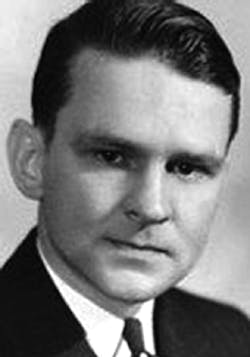This month’s lawman is most noted for the capture of John Dillinger and the less than stellar history between J. Edgar Hoover and himself. He had a law degree from the University of South Carolina and joined the Bureau in 1927. I give you Melvin Horace Purvis, Jr.
Mr. Purvis was born October 24th, 1903 in Timmonsville, South Carolina the fifth of 12 children to Melvin Purvis, Sr. and Janie Elizabeth Mims. In 1925 he received his law degree from the University of S.C. and worked for two years at Willcox and Hardee of Florence, South Carolina as a Junior Partner. After seeking out a position in the State Department as a diplomat (they weren’t hiring) he answered a call from Bureau Director J. Edgar Hoover who was looking to tighten the FBI standards in 1927.
He quickly excelled in the Bureau and headed the Division of Investigation in Birmingham, Oklahoma City and Cincinnati. Hoover personally put Purvis in charge of the Chicago office following some of the most violent years in Chicago’s history (Capone was sentenced November 24, 1931). Despite his lack of performance when it came to administrative duties, Hoover took a personal interest in his career and referred to him as “Little Mel” (as did the press) due to his stature. Purvis was five foot, four inches tall and weighed in at 127 pounds.
He was liked by those who worked for him and was often referred to in the press as “clam personified” because he would not comment on cases and was remarkably short with answers when he did. His dogged determination and painstaking diligence aided him in tracking down some of the most notorious criminals of the nineteen-thirties. Most notable of these was John Dillinger.
In 1933, Dillinger and his group of criminals went on a violent spree of bank robberies through Indiana, Illinois and Ohio amassing an estimated $150,000. Having been captured while hiding out in Tucson, Arizona he was extradited to Indiana. Escaping from Crown Point prison on March 3, 1934 using a wooden gun, Dillinger stole a police cruiser and cross state lines. This made it a federal offense and the jurisdiction of the FBI. Hoover ordered Purvis on the case two days later and Dillinger became the FBI’s Public Enemy Number 1.
Following a botched attempt at capturing Dillinger at “Little Bohemia” in Rhinelander, Wisconsin Dillinger went underground. Purvis would enlist the help of Anna Sage (a friend of Dillinger’s) who came to be known in the press as “the woman in red.” She agreed to help the FBI to avoid deportation back to Romania (but was deported anyway).
On July 22, 1934 Dillinger was setup to be arrested by outside the Biograph Theater in Chicago. Purvis was to signal his agents by lighting a cigar; unfortunately a shootout occurred that resulted in Dillinger’s death. Although Purvis didn’t even fire a shot he was credited as “The Man Who Got Dillinger.” Purvis is also credited for the killing of Charles Arthur Floyd (a.k.a. Pretty Boy Floyd) on October 22, 1934, although there is some disagreement as to the facts of the shooting.
Following all the media attention received from these two cases Purvis was considered a celebrity in the press. According to The Vendetta, a biography written by Alston Purvis (Melvin’s son), he was the second most famous man in America behind President Roosevelt. All this fame didn’t sit too well with Director Hoover, who always had the limelight to himself. He allegedly began to assign all the bad cases to Purvis and put him under increased scrutiny. Many believe it was this treatment that drove Melvin Purvis to resign from the FBI on July 10, 1935. During that time frame the Bureau lost several of its agents, with the attrition often attributed to Hoover’s leadership.
Following his resignation from the FBI, Purvis was unable to secure a job in law enforcement due (speculatively) do Hoover’s black listing him. He retuned to his law practice and would marry Marie Willcox, the daughter of his former law partner. They would have three children: Melvin, Alston and Christopher. He also volunteered during World War II, serving as a Lieutenant Colonel. Even in his law practice Hoover had a hand in trying to keep him from succeeding. Hoover tried to block Purvis’ nomination as special council to the Senate Judiciary Committee but his efforts failed.
Despite all the ill feelings between Purvis and the Bureau he never had a bad thing to say in public about it or Director Hoover. He would always remain faithful to the FBI. On February 29, 1960 Purvis died as the result of a gunshot wound to the head. It was originally deemed a suicide but later accounts deemed it to have been accidental as he was trying to clear a tracer round that had lodged in the barrel. There was no note left and he gave no indication that he would commit suicide. The final word was sent to Hoover by the Purvis family after his death. Hoover did not attend the funeral or send condolences. Marie Purvis wrote, “We are honored that you ignored Melvin's death. Your jealousy hurt him very much but until the end I think he loved you."
About The Author:
Charles Bennett was born in our Nation's Capital and grew up in the Maryland suburbs. Mr. Bennett has been working in all aspects of the publishing industry since the late 1980s primarily in the fields of commercial photography and magazine production. Moving to California in 1992 to attend college resulted in B.F.A and Masters degrees. California also supplied Mr. Bennett with his wife. The two of them are avid sports persons and participate in shooting, scuba diving, surfing, running and bicycling. As a long time hobby Mr. Bennett has studied the legends of American law enforcement which led to his writing these columns.
About the Author
Charles Bennett
Charles Bennett was born in our Nation's Capital and grew up in the Maryland suburbs. Mr. Bennett has been working in all aspects of the publishing industry since the late 1980s primarily in the fields of commercial photography and magazine production. Moving to California in 1992 to attend college resulted in B.F.A and Masters degrees. California also supplied Mr. Bennett with his wife. The two of them are avid sports persons and participate in shooting, scuba diving, surfing, running and bicycling. As a long time hobby Mr. Bennett has studied the legends of American law enforcement which led to his writing these columns.

